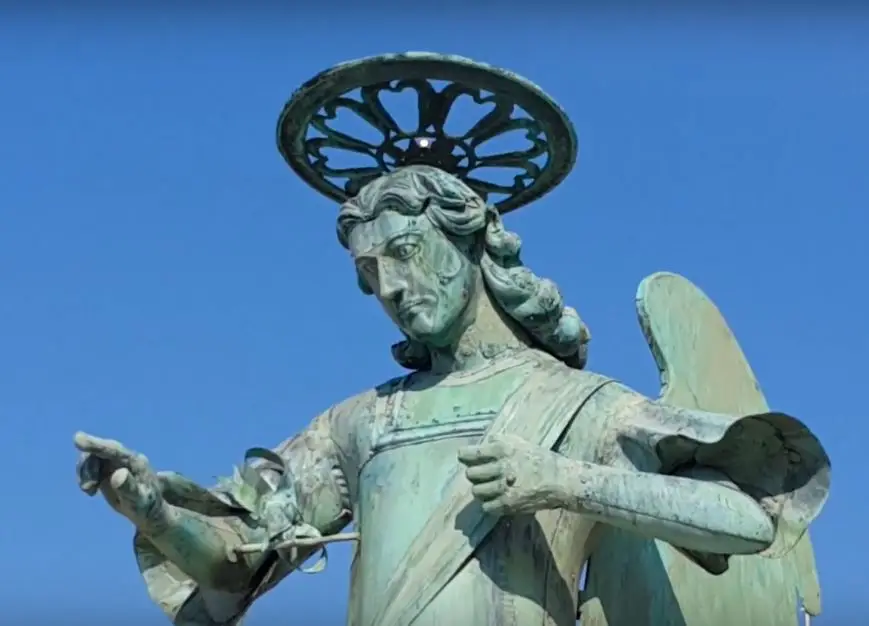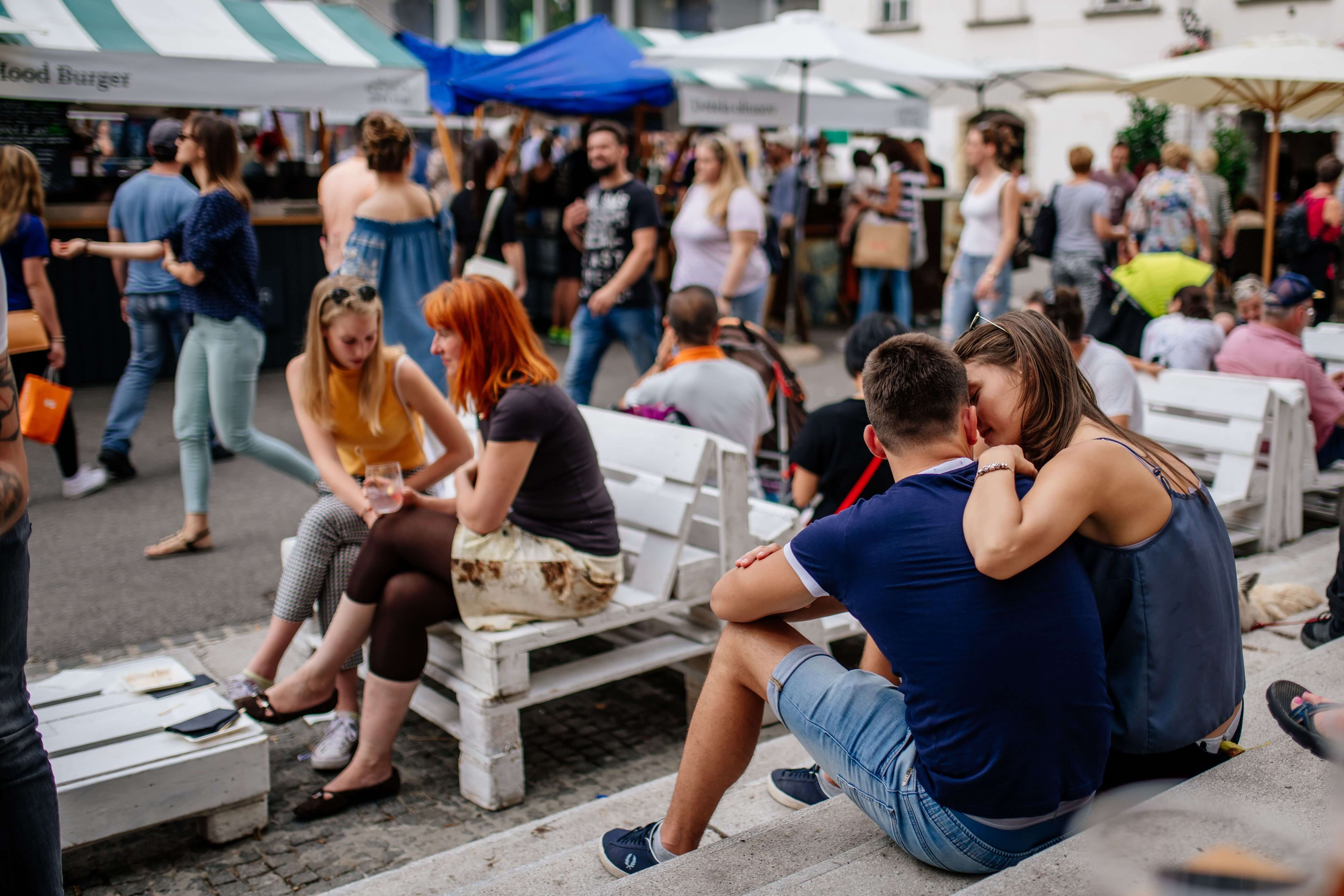Ljubljana related
If visitors to Slovenia go to only one place outside the capital then it’s almost certainly to the picture perfect, chocolate box location of Lake Bled, famed for the views of the church on the island, castle on the hill, and kremšnita on the plate.
While four hours is just about enough to do it all, if you move fast, a day is recommended if you enjoy walking in the open air, and two days if you really want to soak it all in and see a little more of what the site has to offer, which includes swimming in summer, skiing and ice-skating in winter, and fairlytale views all the time.
Essential Sightseeing in Bled: The Island and Castle
The list of essentials around Lake Bled is fairly short and obvious. You’ll want to get good view of the castle and island, visit the island, and eat a kremšnita.
When it comes to the lake all eyes are on the island, with the Church of the Assumption of Mary (Cerkev Marijinega vnebovzetja). This was built in the 17th century and is approached via 99 steps that grooms are supposed to carry their brides up, with the island and Castle here being popular wedding spots. If no one’s getting married on your visit then do go inside and look around. You can also try ringing the bell three times for good luck, something you’ll hear others do throughout your visit.
You don’t need to pay to visit the island, so well done if you choose to swim there or bring your own canoe, but there is a fee if you want to enter the church and bell tower, currently €6 for adults, 4 for students and seniors, 1 for children, and 12 for families. Other places to explore on the island include the chaplain's house, provost's house, and a small hermitage – more than enough to make the trip across the water worthwhile, whether or not you have a wedding to attend.
The most touristy way to get to the island – not that there’s anything wrong with that – is via a traditional Pletna boat, powered by an oarsman who stands up (currently €15 return for adults, €8 for children), with these leaving from the Health Park, Hotel Park and the rowing centre (for more locations, see here). If you want to hire a kayak, rowboat or stand-up paddleboard, then Google will help, while if you come in winter the lake might be frozen, and you can simply walk or skate across (at your own risk, of course)
That said, you won’t get a good view of the island from the island, for that you’ll want to get up above the water. If you fancy a a short hike, of between 45 minutes to an hour in each direction, then three popular spots for this are the 611 m hill known as Ojstrica, or Osojnica’s two viewing areas, Mala (Small) at 685 m and Veliki (Big) at 756 m.
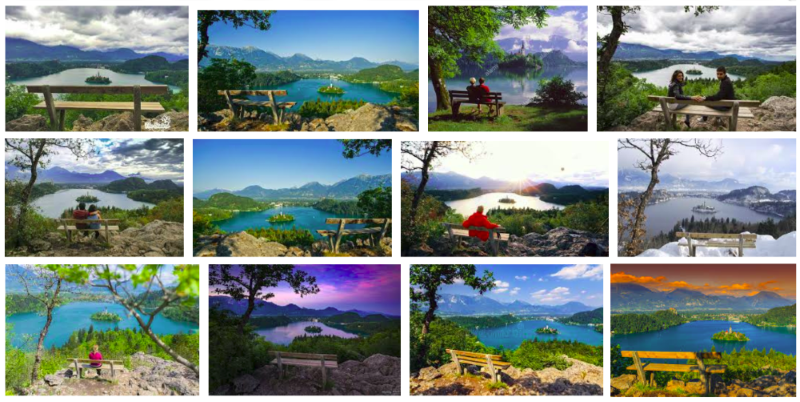
Source: Google image search
These are where you see a lot of Instagram shots, and you can find out how to take a picture like the ones above here. However, with about 90 minutes to two hours for the round trip you might want to find other options if just here for a short visit.
In which case, don’t worry, the view from Bled Castle is just as good. What’s more, if you’re really pressed for time then the short drive, bus ride or 15-minute walk up the hill will let you kill two or three birds with one stone – see the Castle, get the view, and eat one of those cakes, which we’ll get to, I promise.
The Castle, set atop a 130 m cliff, first appears in written records in 1011, and over the years the various owners have made their own changes to the property, making it the attractive mix of styles you’ll see today. Entrance costs €11 for adults, 7 for students and 5 for children enter (although free if you book a table at the restaurant), and inside you’ll find a museum, wine cellar, forge, printing press, chapel, knights’ hall restaurant, souvenir store and yet more impressive views of the area, which are not limited to those of the island.
What to Eat in Bled
Not every place has a “must eat” dish, but Bled surely does, and – as noted above – it’s kremšnita, which you’ll find everywhere. This is a truly delicious slab of custard, cream and pastry, perhaps best enjoyed with a cup of coffee. Another dish to consider, and before the kremšnita if you have enough time, would be fish from the lake.
If you’d like to make your own kremšnita, then you can see our recipe here. It failed, in part, but you can learn from our mistakes and / or simply appreciate the craft that goes into making “the real thing”.
Things to do with 24 to 48 hours in Bled
If you stay longer, and there are plenty hotels where you can spend the night, then you can really explore the area. In this regard hikers are in for a treat, with many paths and trails offering stunning views in the surrounding hills, or you can keep close to the water and follow the 6 km trail around the lake.
In the winter months skiing is possible, as is skating, while at other times you can enjoy a winter sport on rails with a toboggan ride – the details are here and a video is below.
Turning back to the lake itself,and season permitting, fishing is allowed, with Bled recently listed among the “ten best fishing holidays in Europe”.
While we’re on the subject of “best of” lists, golfers should note that in 2018 Royal Bled was added to the list of “best and most beautiful courses”, which is hardly surprising when you consider the views on offer as you walk from hole to hole.
Finally, if you’be spent a day or two exploring the area then consider taking a soak in one of the many spas in the town, with the water coming from the natural hot springs on the north-east side of the lake. In short, Bled offers much more than a cake with a view, and will reward visitors who choose to stay a day or two longer than most.
If you want to keep up with all the news about the area, including the things they don’t tell the tourists, then you can do that here, while if you want to visit the local tourist centre’s website to find out about the latest offers, then you can find that here.
Part of the appeal of Slovenia as a destination is the remarkable variety of landscapes, climates, cuisines and cultural heritage packed into a relatively small area, due to the young nation’s position at the crossroads of north, south, east and west Europe. Piran, and the Slovenian coastal region of Istria in general, is a fine example of this, giving the country and access to the Adriatic as well as an area famed for its wines, olives, persimmons, seafood, architecture and – on occasion – wind (known as the burja or bora). For both short-term visitors and life-long residents of Slovenia it represents an escape from the inland and the chance to enter another, more Venetian world, an opportunity that should be seized whenever possible.
We thus present a short guide to spending from four to 48 hours in Piran, with a choice of sights and activities that isn’t meant to be exhaustive, or exhausting, but rather a simple presentation of things to see and do that’ll let you say: “Yes, I’ve been to Piran, and I loved it”.
Essential Sightseeing in Piran: The Old Town and the Sea
The town is an old Venetian settlement, ruled by the lagoon-based city state from 1283 to 1797, and this history can still be seen in many of the more notable buildings. The town’s proximity to Italy also means that Piran, or Pirano, is essentially bilingual, as seen in the two languages on the signs and often heard in the accented dialect of locals. The best place to see Venetian architecture is in the Old Town, basically the whole of touristic Piran, which can easily be explored on foot in a few of hours – it’s mostly pedestrianised – with breaks for cafés, light shopping and food.
Notable buildings include the Benecanka Casa Veneziana Pirano, aka the Venetian House, now a boutique hotel, but one that you can still enjoy from the outside. It’s long been a tourist attraction, as seen in the postcard below, and is said to have been built by a Venetian merchant for a local women he fell in love with.
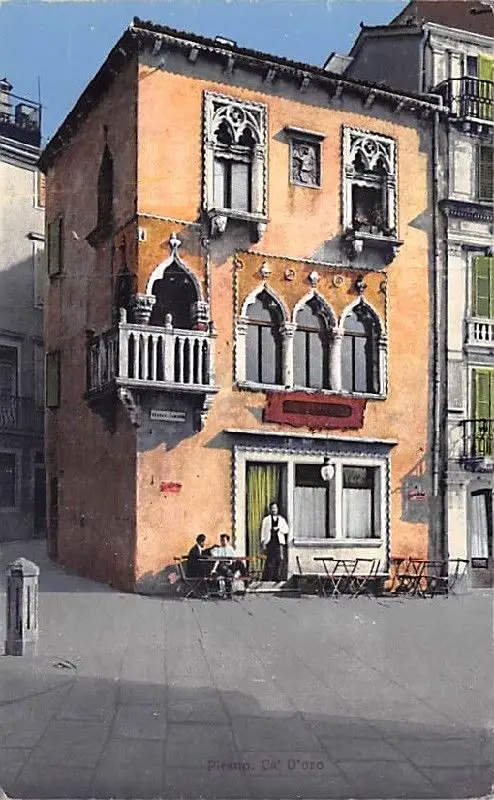
Postcard of the Venetian House, 1914. Source: Wikipedia
Venetian House can be found on the edge of Tartini Square, named after the composer Giuseppe Tartini (1692-1770), the first recorded owner of a Stradivarius. As old as it may look, this square is relatively recent. It was an open dock until 1894, when – the locals having grown sick of the smell of the sewage and waste that floated in the waters – it was filled in, with the statue of Tartini being placed there two years later.
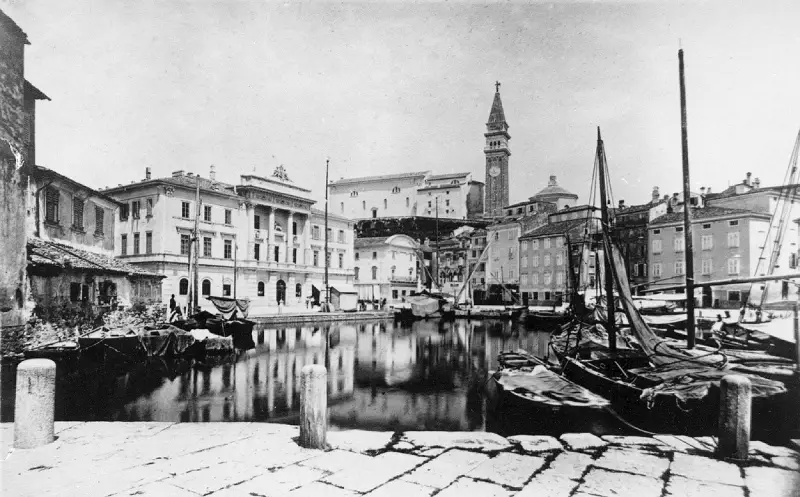
Photo of the dock that became Tartini Square, taken in the late 19th century, with Venetian House roughly in the middle. Source: Wikipedia
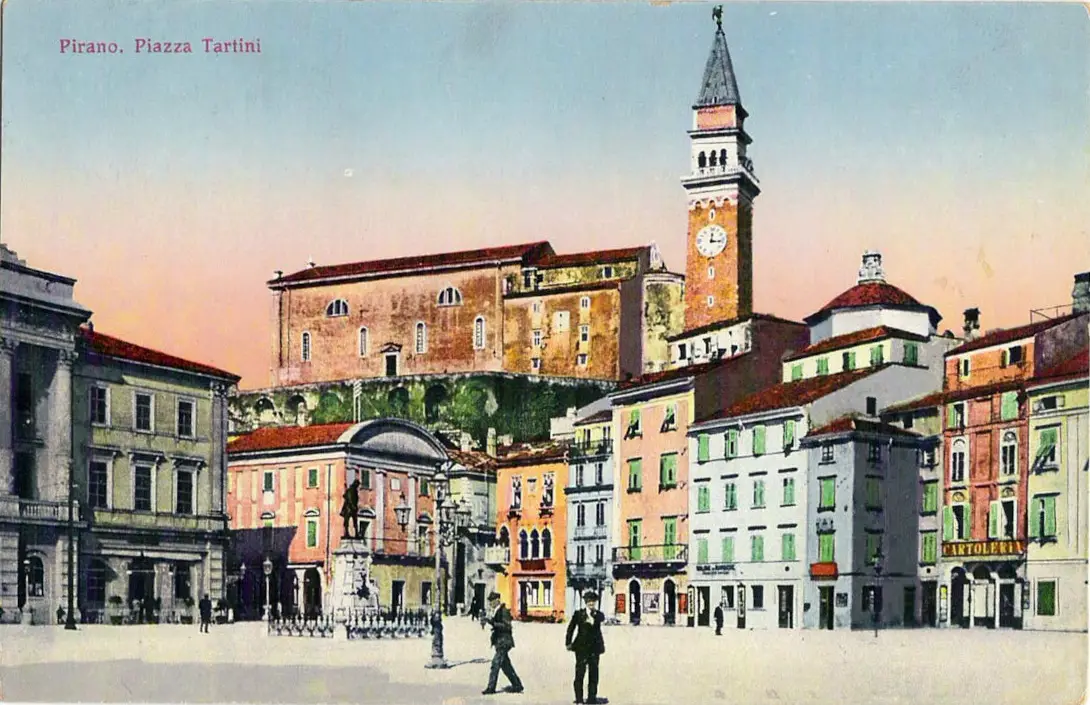
Postcard of Tartini Square in 1915. You can see the Venetian House behind the two men. Source: Wikipedia

Tartini Square in 200. Source: Wikimedia - © Plamen Agov • studiolemontree.com CC by 3.0. You can see more old photos of the square here.
It’s from this square that you can see another icon of Piran, the statue of the Archangel Michael, which for a little over 250 years has been sitting atop the church of St George, moving to show the direction of the wind to the town’s seafaring residents. (It was taken down for a short time 2018, for some much needed repairs)
St Michael. Screenshot from YouTube
Another structure to seek out are the Cloisters of Saint Francis Monastery, a place that still houses Franciscan monks and one that’s known for having great acoustics. For that reason it hosts the Piran Music Evenings and Tartini Festival, with the latter taking place late summer (this year, 2019, from August 22 to September 9), with the official website here.
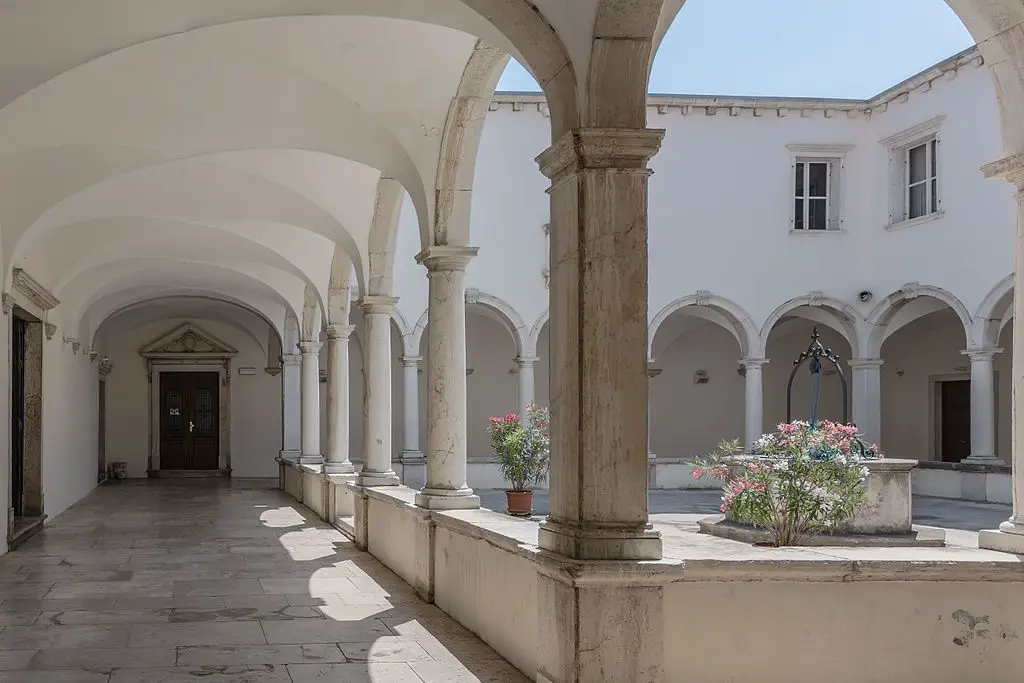
The Cloisters. Wikimedia - Isiwal CC-by-4.0
Before or after your walk around town you might want to sunbathe or swim, and you can do so at various spots, with some of what to expect (no sand) shown in the following video from Korea.
Things to do with 24 to 48 hours in Piran
Once you’ve seen the Old Town and bathed in the sun and/or the sea, you might want to take in some more of the related cultural and touristic offerings. These include the Sergej Mašera Maritime Museum, Piran Aquarium and the Museum of Underwater Activities(website down, at the time of writing), all of which offer what the names suggest. You can also find details of upcoming festivals, concerts and other events in Piran here.
If you’re spending longer in Piran then you might want to see a little more of the coast, that 47-km of Slovenia that separates Croatia from Italy. Within walking distance, or an easy cycle, drive, taxi or bus ride, is Portorož, a Riviera-style resort town with a very different feel to the Venetian peninsula. It’s here you’ll find casinos and beaches with recliners and umbrellas, with everything from top hotels and classy restaurants and a marina to pile ‘em high, sell ‘em cheap stores selling flip-flops, sunhats, sunglasses, inflatable items and so on. It’s not for everyone, but then neither is climbing Mount Triglav, so if it sounds interesting to you then take a look.
If you want to see more of the Venetian side of the coast then head on to Izola, although only if you haven’t been to Piran first. Meanwhile, the economic centre of the Slovenian Istria (aka Primorska) is the port town of Koper. While a little more developed than its neighbours, it still has another charming Venetian Old Town to explore.
Two areas that are more untouched, and where you’ll probably want to take your own food and drink, are Strunjan and Debeli rtič. Strunjan is a coastal nature reserve with many paths and trails for walking, hiking and biking, and the ideal place to get away from the crowds and ice sellers for a few hours. You can read our more detailed guide to this hidden treasure on coast here. A similar kind of experience can be had at Debeli rtič.
Tourist shopping in Piran
Piran is known for its salt pans, once the source of its wealth, and these are still in business, producing the famed local fleur de sel. Even if you don’t make the trip to see the seawater evaporating leaving these precious crystals, you’ll find stores all over town selling the stuff, both as a cooking ingredient and in various other preparation. Not made in Piran itself, but still in Slovenian Istria (aka Primorska or the Littoral), you might want to look out for local wines and produce. Wines offer include the red Refosco and white Malvazija, although there are also many other varieties and blends to enjoy, as outlined in this earlier article, while olives and PDO designated olive oil are produced nearby and are worth picking up or seeking out in restaurants.
Food and drink in Piran
As noted above, the region produces plenty of very drinkable wines, and often at prices lower than they’d command if they came with an Italian name, so do explore these if a fan of the grape. With regard to food, since you’re by the coast you should take the chance to check out the seafood restaurants. You’re also next to Italy, so don’t feel like you’re betraying Slovenia if you order some pasta and gelato.
If you’d like to learn more about Piran, including the stories that don’t make it into the tourist guides, then you can find all our articles on the town here
Most visitors only spend a day or two in the capital, so what follows is a few suggestions on how to enjoy from four to 48 hours in Ljubljana, starting with the essential then going on to the more optional, and often more enjoyable, items. It’s a personal list with an eye to pleasing a wide audience, so feel free to disagree and choose your own adventure - I've been living here five years, and am still not bored with the city.
Related: 25 things to know about Ljubljana
The locations named in the text – all except the Zoo are close to each other

A view from the Castle: Photo JL Flanner
Essential Sightseeing in Ljubljana: The Castle and Old Town
If you only have a few hours in the city then there’s really only two things you have to do, see the Castle (and Old Town. If you’re able to walk then you can get to the Castle on foot in around 20 minutes and if not there’s a funicular (3) that’ll take you up and down a lot faster. But if you have the time and mobility then on foot is recommended, as you’ll save some money and get some exercise, along with an idea of how well defended the place was when attackers would need to trudge up while being fired down upon.
Much of the Castle can be enjoyed without a ticket, but if you do buy one you’ll get to go to the top of the tower for the best view in town, as well as entrance to various exhibitions. If you want to read up on the place beforehand, or while you’re there, then check out our 25 things to know… or 10 ways to enjoy Ljubljana Castle.
The Old Town is basically a street that runs from the Central Market (4) to Gornji trg (5), with the whole thing lined with attractive buildings housing boutiques, restaurants and cafés. You can easily go from one end to the other, without stopping too much, in 30 minutes, but you probably want to pause and explore, especially some of the lanes. You should also make time to walk by the River Ljubljanica, ideally along both sides so you get to see the colourful and well-preserved mansions that give this part of town a very picturesque chocolate box look.

Everyone takes a picture at Dragon Bridge. Photo JL Flanner
Even if only in town for a half a day you’ll also want to see Dragon Bridge (6), although be prepared to be underwhelmed. Far prettier, in my opinion, are Triple Bridge (7) and Cobbler’s Bridge (8), and the best place to take pictures of both is from the easy to miss Fishmarket Footbridge, as outlined here.
Taking a picture from Fishmarket Footbridge. Photo JL Flanner
Things to do with 24 to 48 hours in Ljubljana
If you have more time in town then you can take in some culture, nature and nightlife, with plenty of options for all tastes, and all packed into or nearby the pedestrianised area.
“The best” is obviously subjective, so here I’ll just focus on the museums and galleries with the broadest appeal and biggest collections. If you like art then you’ll want to check out the National Gallery (9) and the Modern Gallery’s main branch (10), both near Tivoli Park. The former has everything from the Middle Ages to mid-20th century, while the latter contains the nation’s collection of modern art, with contemporary art housed in another branch by Metelkova. With regard to museums, the big two are the National Museum of Slovenia (11) and the City Museum (12), focusing on Slovenia as a whole and Ljubljana in particular, respectively.

Contemporary art at the Modern Gallery's Metelkova branch. Photo JL Flanner

Street art: Photo: Alternative Ljubljana
Metelkova (13), the city’s graffiti-covered squat turned art space / autonomous area is worth visiting in the daytime to see the grittier side of the art scene, while at night it plays hosts to various music and performance venues. Note that unlike some similar looking places in Europe it’s not an open (or legal) drug market, so don’t go looking for trouble (or expecting it).

The Opera House is one of Ljubljana's many beautiful buildings. Photo: Wikimedia - Grega Pirc CC-by-4.0
For nightlife beyond cafés and bars there are plenty of clubs and live music venues, and a usual week will see these offering a broad range of music, from classical to techno, death metal to jazz, flamenco to dub, house music to experimental noise, with many all-night events, while there’s also a ballet and opera house, along with a number of cinemas. For all of these the best place to find out what’s on is TSN’s very own What’s on in Ljubljana this Week.

Tivoli Park. Photo: D Wedam for Visit Ljubljana

Further upriver. Photo: bananaway.eu
For children, in addition to the Castle, consider trips to the Puppet Theatre (near 3), the very popular Museum of Illusions or Ljubljana Zoo (13) (I haven’t been, but also haven’t heard bad things). Check out our obligatory Top 10 things for kids in Ljubljana story here.
Photo: Open Kitchen
Fine dining, street food and cafés in Ljubljana
If you want to eat “the best” then you can head to a review website and find something to your taste. The names that come up most with regard to fine dining are Strelec (in the Castle) and JB (14) on the architecturally interesting Miklošičeva Street , although check the prices before sitting down. Cheaper options are easy to find, and while Slovenian food is good there’s no real “must-eat” dish to put on your schedule, so relax and eat what you want. If that’s “ethnic food”, then head to Trubarjeva cesta (15) . If hungry after midnight then your options are very limited, but a few places can be found here. If visiting in the warmer months, and on a Friday, then don't miss Open Kitchen in the marketplace next to the Cathedral.
With regard to cafés and bars, the best thing is just to find somewhere with a free table that looks like your kind of thing, order a drink and settle down, as with most of the places you get what you see or hear from the outside.
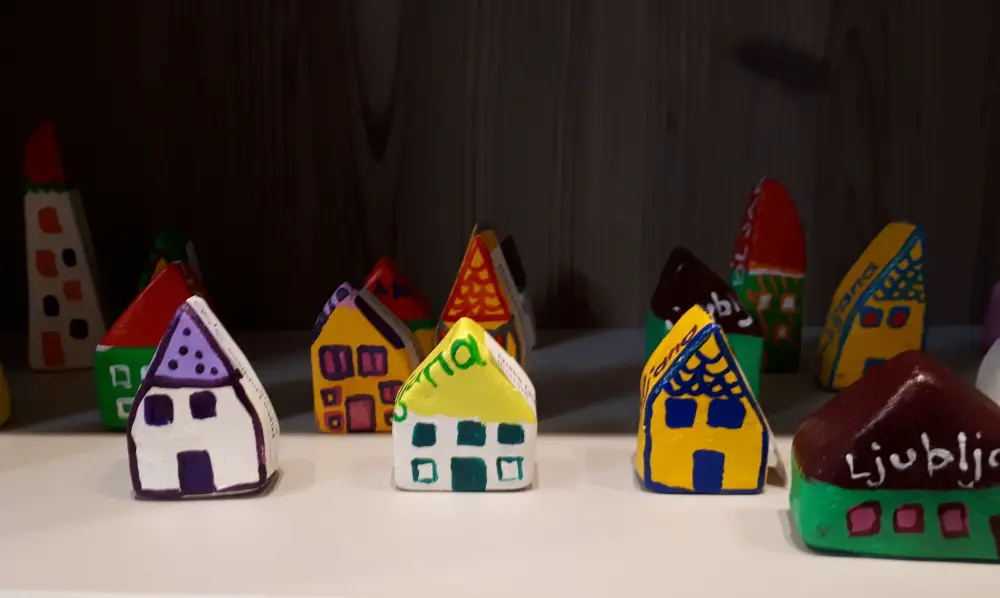
Photo: JL Flanner
Tourist shopping in Ljubljana
Ljubljana isn’t known for its shopping, with most of the more functional stores out of town at the massive BTC shopping complex, which isn’t really worth visiting if you’re a tourist. No, if you’re just looking cute boutiques and places to pick up a souvenir then the Old Town will have you covered, while if you need any toiletries or stationary then head to Müller (16), on Čopova (near the McDonald’s).
If you need prescription drugs, or even just aspirin, head to the Lekarna (17) in Prešeren Square (the one with the big pink church by Triple Bridge). When I travel I like to visit supermarkets, both to pick up some snacks and drinks for my hotel room, and to get some idea of the local products on offer. The two main chains in town are Spar and Mercator, which you’ll come across just walking around. However, note that while this is a capital city there are no 24-hour, or even very late night, convenience stores, so do your shopping before 20:00 or risk disappointment.
Photo: Wikimedia - Thomas Geiregger CC by 2.0
Getting around Ljubljana
Everything is within easy walking range, if you find walking easy, although if you want to experience the city “like a local”, and see more, faster, then rent a bike. These can be borrowed from the city’s Bicikelj system, but can also be rented from various hotels and hostels, so if you’re spending the night somewhere ask there. There are city buses, but if you’re only in town for a day or two then you’re unlikely to need one.
If you’re in a wheelchair or less mobile than you’d like then don’t worry. Ljubljana is an old city, and there are still steps in many places, but the municipality is also working hard to improve accessibility. The best way to learn about this, and to find out which places have ramps, where the Eurokey bathrooms are, and so on, is with the Ljubljana by Wheelchair app.
In short, whether spending four or 48 hours in Ljubljana there's plenty to enjoy without feeling too rushed, and if you’re a first-time visitor then I envy the pleasures of discovery that await you.


